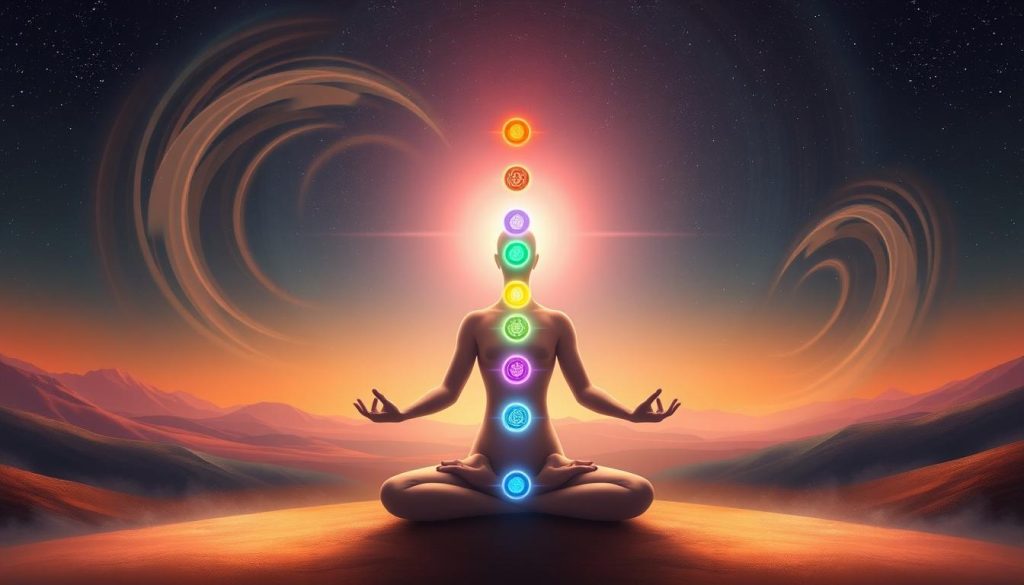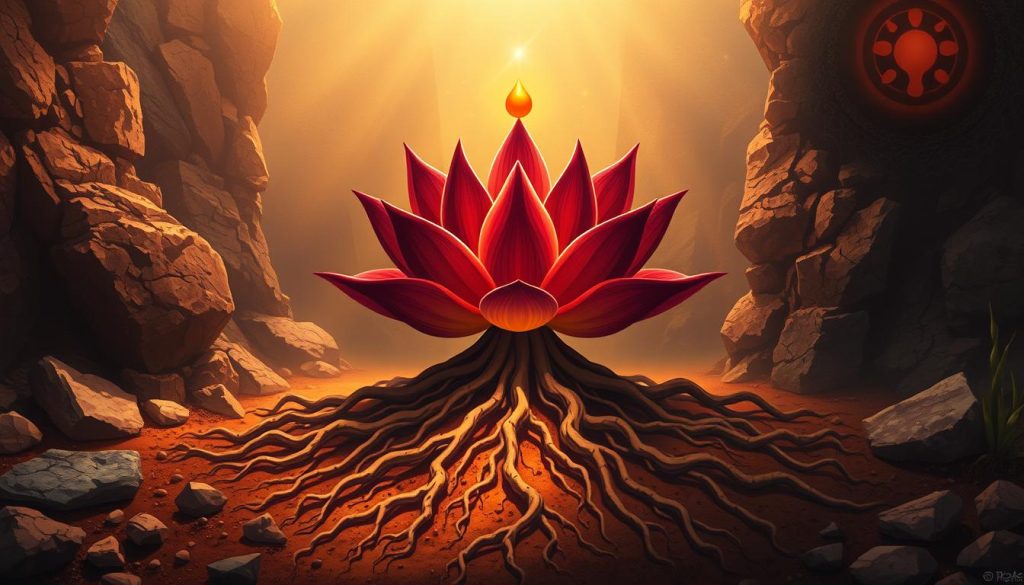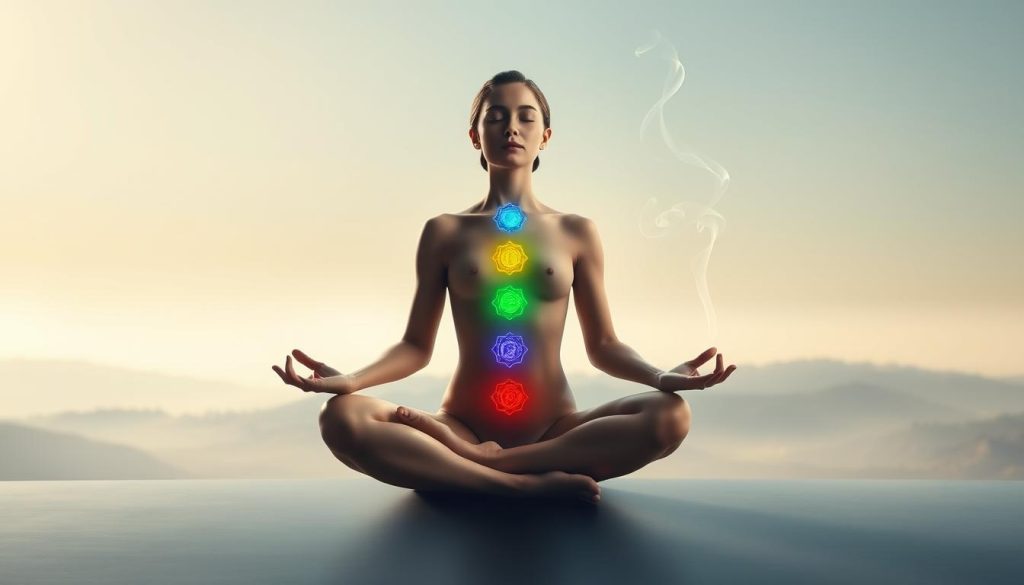Welcome. We invite you on a gentle tour of the chakra map—those subtle wheels of energy that run along the spine. These centers link glands, emotions, and nervous rhythms so our body and mind sing in sync.
We blend ancient notes and modern findings. Think prana as bioelectric flow, EEG hints from meditation, and simple tools like breath, color, and sound. This guide will show small rituals and checks you can try today to help your energy feel grounded and alive.
Key Takeaways
- Chakra centers are energy hubs that connect physical glands and feelings.
- Balancing each chakra can boost mood, health, and daily choices.
- Modern science and yogic texts both inform practical, safe methods.
- Simple practices—breath, posture, color, sound—shift nervous system tone.
- We’ll travel from root to crown with playful experiments and clear signs to watch.
Understanding the Chakra System: Energy Centers Along the Spine
Visualize an inner highway where energy moves up from roots at the spine toward an open crown. This map names seven main hubs that guide breath, mood, and attention. In Sanskrit, chakra means “wheel.” Each wheel acts like a station in our subtle body.
We call this network a chakra system. These energy centers sit in the astral body and link to glands and feelings. Thousands of nadis weave around a central channel, the sushumna nadi, which lets prana rise from base to crown.
Chakras do not show on scans, yet they shape health through patterns of breath, mood, and resilience. Think of each center as signal strength. When a station dims, attention and behavior shift. When it hums, consciousness widens.
Later we’ll offer simple tools—breath, sound, visualization, and movement—to restore clean flow across these centers. For now, picture the spine as a route where energy meets mind and body in steady exchange.
What “chakra” means and how energy flows in the subtle body
- Wheel: a rotating hub that transforms prana into feeling.
- Sushumna nadi: main pathway from base spine up to crown.
- Practical note: breath and posture reveal hidden imbalance.
From base of the spine to the crown: the sushumna nadi pathway
The route links each center so energy can be received, refined, and passed on. As we practice, that pathway becomes more clear and usable in daily life.
Why the 7 Chakras Hold the Key to Mind-Body Balance
Each chakra marks a step in how we sense safety, desire, and higher knowing. These stages trace a path from survival at the root up to freedom from illusion at the crown.
Awareness from survival to freedom
We map seven levels: survival, desire, intellect, compassion, acceptance, clear perception, and spiritual freedom. Each level links to a specific energy center and a style of awareness.
How balanced centers shape emotions, health, behavior
When energy centers hum in coordination, mood stabilizes and thought becomes clear. Body systems often follow; resilience and steady health tend to rise.
“Coherent flow feels like vitality; jamming feels like stress.”
| Level | Theme | Everyday sign | Effect |
|---|---|---|---|
| Root | Safety | Money fear, hypervigilance | Grounding restores calm |
| Sacral | Desire & creativity | Blocked intimacy or dull creativity | Flow returns pleasure |
| Solar Plexus | Will & confidence | Low boundaries, doubt | Balance boosts decision-making |
- Small, steady practices nudge awareness upward.
- We listen to signals, tune the system, and practice together.
Origins and Philosophy: From the Vedas to Modern Yoga
Scriptures and sages shaped a practice that links breath, sound, and subtle anatomy. Ancient Vedic and Upanishadic texts first sketched a map of inner centers that later teachers refined into a working system for daily life.

Vedic roots and Tantric, Hatha threads
Early hymns describe channels and centers where prana gathers. Tantra and Hatha yoga wove in mantra, breathwork, and movement so that these ideas became methods you can practice.
Nadis, prana, and kundalini at the base
Nadis are subtle channels; the sushumna sits at their core and links the centers. Kundalini, often pictured as a coiled serpent at the base spine, is latent life energy that can rise with steady practice.
Practical note: In this framework, chakras act as organizational centers for prana reception and transmission. Chanting, posture, and mindful breath help circulate energy and expand consciousness.
- Ancient insight made useful through modern yoga tools.
- Steady, gentle practice nurtures clarity and joy—not drama.
Where Science Meets Subtle Energy Today
We translate ancient signals into modern measures. Framing prana as bioelectricity helps us see how energy moves through the body. Researchers report links between breathwork, meditation, and changes in EEG patterns. These shifts often match reports of clearer mind and more steady mood.
Chakra centers correlate with major nerve plexuses and endocrine glands. That gives a plausible bridge: subtle center maps and measurable physiology interact. Studies show autonomic markers shift after breath and meditation, which may explain reduced stress and improved health.
Somatic healing and yoga use movement and breath to free stuck patterns. Gentle asanas, attention, and paced breathing can restore flow and calm nervous tone. This is not proof of mystical claims, but a useful lens that supports what long-time practitioners noticed.
| Aspect | Modern correlate | Observed effects |
|---|---|---|
| Prana | Bioelectric signaling | Altered EEG coherence, mood gains |
| Chakra locations | Nerve plexuses & glands | Hormone balance, autonomic shifts |
| Practices | Asana, breath, meditation | Reduced stress signatures, increased vitality |
- Takeaway: science and practice meet as complementary maps.
- Use simple breath and movement to test what feels true for your body.
The Seven Main Chakras at a Glance
Let’s pin simple labels to each chakra so you can spot strengths and soft spots fast.
Think of these centers as jewels on a central cord. Each jewel has a color, an element, a place in the body, and a core psychological theme.
- Root — Red; element: earth; location: base of spine; theme: safety and grounding. Balanced: calm and steady. Off: money fear, hypervigilance.
- Sacral — Orange; element: water; location: lower abdomen; theme: emotion and creativity. Balanced: playful flow. Off: dull creativity or blocked intimacy.
- Solar Plexus — Yellow; element: fire; location: navel/upper abdomen; theme: power and will. Balanced: confident action. Off: low boundaries, doubt.
- Heart — Green; element: air; location: chest; theme: love and compassion. Balanced: open connection. Off: guardedness or numbness.
- Throat — Blue; element: sound/space; location: throat; theme: communication and truth. Balanced: clear expression. Off: silence or harsh speech.
- Third Eye — Indigo; element: light; location: between brows; theme: intuition and inner sight. Balanced: clear insight. Off: fuzzy focus or overthinking.
- Crown — Violet/white; element: thought/spirit; location: top of head; theme: unity and higher meaning. Balanced: peaceful perspective. Off: disconnection or scattered thought.
| Center | Color | Element | Location in body | Balanced sign |
|---|---|---|---|---|
| Root | Red | Earth | Base of spine | Grounded, secure |
| Sacral | Orange | Water | Lower abdomen | Creative flow, ease with intimacy |
| Solar Plexus | Yellow | Fire | Navel / upper abdomen | Confident, decisive |
| Heart | Green | Air | Chest | Compassionate, open |
| Throat | Blue | Sound / Space | Throat | Truthful, clear voice |
Quick metaphor: earth roots you, water moves you, fire fuels you, air opens you, sound frees you, light guides you, and spacious thought unites you.
Next up: we’ll deep dive into the root center with practical rituals and simple yoga moves you can try today.
Root Chakra (Muladhara): Grounding the Energy Body
At the base of our spine lies a steady red hub that anchors breath, nerves, and simple safety.

Muladhara plants us in survival and stability. Its element is earth. When this chakra hums, our nervous system and basic needs feel supported.
Location, color, element, and survival emotions
The center sits at the base spine and glows red. It governs feelings of safety, shelter, and belonging. Grounded Muladhara brings calm, confidence, and steady presence.
Blocked signs vs. balanced effects; yoga poses and mantra
When blocked, common symptoms include instability, financial fear, hypervigilance, and fatigue.
Balanced, we move with steady will, clear boundaries, and ease in daily life.
- Simple practices: earthing, slow squats, steady breath to restore flow.
- Yoga poses: Mountain (Tadasana) and Tree (Vrkshasana) activate stability.
- Mantra: the seed sound Lam and short affirmations retrain safety from inside out.
- Support: root vegetables, red accents, and regular outdoor contact help body and energy align.
Sacral Chakra (Svadhishthana): Creativity, Water, and Emotions
Imagine a warm orange tide pooling beneath the navel—this is Svadhishthana.
Location: lower abdomen. Color: orange. Element: water.
Energy flowing versus blocked patterns
When energy flows here we feel sensuality, playful creativity, and steady vitality. Inspiration arrives with ease. Movement and music often unlock ideas.
When chakras blocked, common signs are emotional numbness, manipulation, or obsession with sex. Guilt and creative stalls can show up. We learn to spot these shifts fast and respond kindly.
“We tune into Svadhishthana’s watery rhythm to thaw numbness and open creative tides.”
- Use hip-openers and dance to invite flow.
- Seed sound Vam melts old tension.
- Yoga poses like Triangle (Trikonasana) and Crow (Kakasana) free pelvic energy.
- Foods, oils, and orange tones—juicy fruits, sweet spices—support the senses.
- Journaling, mindful pleasure, and short rituals treat emotion as data, not drama.
| Sign | Balanced | Blocked |
|---|---|---|
| Sensuality & creativity | Playful, inspired | Dry, stuck |
| Emotional tone | Fluid, attuned | Numb or reactive |
| Practical tools | Dance, hip-openers, Vam | Avoidance, over-control |
Solar Plexus Chakra (Manipura): Personal Power and Will
A bright yellow center at the navel fuels our drive and shapes how we act in the world. This hub governs will, decision-making, and how we metabolize stress—physically and emotionally.
Digestive fire, confidence, and common symptoms
Location: navel / upper abdomen. Color: yellow. Element: fire.
When dim: digestive flares, low self-esteem, anger, or perfectionism can show up. Harsh inner critics and indecision are common signs.
When balanced: confidence, productivity, and clear boundaries emerge. Upward energy shows as generosity and joy; downward tone can turn into jealousy or greed.
Best yoga poses, breath, and mantra for practice
We stoke Manipura with focused movement and breath. Try Forward Bend to fold inward, Cobra and Bow for gentle back activation, and Boat or plank progressions for core strength.
- Breath of Fire energizes while regulating gut tone.
- Seed sound Ram anchors will and clears tension.
- Short meditation on the navel helps sense steady heat, not flare-ups.
“We ignite this fire for decisive action, strong boundaries, and steady metabolism of stress.”
| Sign | Blocked | Balanced |
|---|---|---|
| Digestive & mood | Flares, anger, doubt | Clarity, courage, consistency |
| Practice | Avoidance or rumination | Breath of Fire, core work, Ram |
Heart, Throat, and Third Eye: Connection, Expression, and Insight
A softer chest, an honest voice, and a calm gaze form a trio that shapes how we connect and perceive. We move from feeling to speech to inner sight in a simple arc.
Anahata — love, compassion, air
Heart chakra sits in the chest. Its color is green and its element is air. When open, love becomes steady compassion; when closed, jealousy and fear can show up.
Practice: gentle backbends like Fish and Bridge and the mantra Yam soften the chest and steady energy.
Vishuddha — truth, sound, communication
Throat chakra lives at the throat. Blue tones and resonant sound help honest speech. Blocks look like timidity or over-talking; balance brings clear expression.
Practice: Shoulderstand and Plough, plus the mantra Ham, open pathways for authentic voice.
Ajna — intuition, light, perception
Third eye chakra sits between the brows. Indigo light guides inner sight. Foggy thinking or headaches can flag imbalance; steady focus returns insight.
Practice: drishti, quiet meditation, and the seed sound Om. Research links focused practice with EEG shifts in attention and clarity.
| Center | Color | Balanced sign | Practice |
|---|---|---|---|
| Heart | Green | Empathy, steady love | Fish, Bridge, Yam |
| Throat | Blue | Clear, kind speech | Shoulderstand, Plough, Ham |
| Third eye | Indigo | Intuition, insight | Drishti, meditation, Om |
“We link feeling, voicing, and seeing so inner and outer worlds match.”
Crown Chakra (Sahasrara): Consciousness and Inner Peace
Here we rest in pure noticing, where daily chatter softens and space arrives.
Sahasrara sits at the crown of the head. Its color is violet‑white. This chakra links spiritual unity and calm awareness.
When balanced, we find inner peace and a gentle sense of spiritual understanding. Life feels intimate and simple, a steady meeting with love and curiosity.
Blocked signs include frustration, dull melancholy, or feeling cut off from meaning. Gentle silence, soft breath, and time in nature help restore clarity.
- Practice: short stillness sessions and simple meditation to settle noisy thoughts.
- Tools: violet-white visualization and the chant Aum to tune subtle energy.
- Nurture: light foods and sunlight to keep body and mind clear.
Remember: unity isn’t an escape. It is intimate presence with life, right where we stand. Sahasrara soothes the whole system and helps all chakras align in quiet clarity.
How to Tell If Your Chakras Are Blocked—and What It Feels Like
Signs of stuck energy often show up as small aches, sudden mood swings, or a fog that won’t lift. Those clues live in body, mind, and subtle sensation.
Physically, blockages may appear as digestive issues, headaches, low back pain, or hormonal shifts. Emotionally, we notice anxiety, numbness, or bursts of fear. Energetically, you might feel fog, stuckness, or uneven vitality.
Here are quick chakra-by-chakra snapshots you can match to your day:
| Center | Common sign | Typical effect |
|---|---|---|
| Root | Fatigue, low back pain | Unease, money fear |
| Sacral | Libido swings, hormonal upsets | Creative block, emotional reactivity |
| Solar Plexus | Reflux, adrenal tiredness | Low confidence, indecision |
| Heart to Crown | Chest tightness; throat soreness; insomnia; migraines | Guarded emotions, stuck voice, fuzzy focus, light sensitivity |
Simple map and kind response
We map signals—body sensations, emotional patterns, and energetic static—to find where attention is needed. Stress and trauma can skew flow; that’s normal and not a failure.
Remember: centers interact. One jam can ripple across the whole system, so gentle, whole-body care works better than forceful fixes.
“Breathe, scan, and note where attention lands—this becomes your map for the next tiny practice.”
- Notice repeating symptoms without judgment.
- Match sensations to likely centers before choosing a practice.
- Use the self-check: three slow breaths, body scan, name what you feel.
Balancing Practices: Yoga Poses, Chakra Meditation, Breath, Diet, and Mudras
Simple daily rituals stitch energy into a steady, usable rhythm. We offer a compact set of tools you can fit into a busy morning or a short evening reset.

Designing a daily routine for steady energy flow
Aim for three short moves: a few yoga poses, one breath set, and a brief chakra meditation. This combo keeps energy coherent without overwhelm.
Try two yoga poses that open hips and chest, a 1-minute box breath, then a 3-minute guided meditation. Repeat some micro-mudras at your desk for a quick reset.
Color therapy, affirmations, and mantras for each energy center
Pair each center with a color cue, a short affirmation, and its seed mantra: Lam, Vam, Ram, Yam, Ham, Om, Aum. Use sensory supports: grounding roots, hydrating fruits, leafy greens, warming spices, and essential oils to nudge mood and health.
- Desk-ready: thumb-and-index mudra, neck rolls, soft humming to shift tone.
- Habit loop: cue (alarm), routine (10-minute flow), reward (tea or short walk).
- Tools: sound timers and tracks at www.mysticbolt.com to help consistency.
“A brief, daily practice builds upward flow that invites creativity, generosity, and calm.”
Conclusion
As we wrap up, remember that quiet daily attention shifts how energy moves through life.
Balance grows breath by breath, pose by pose, day by day. Small rituals—asana, simple breath, a short meditation, or a finger mudra—help the chakra map become useful in real life.
We celebrate this inner map: seven centers, one system, and a practice of kind awareness that turns subtle flow into ease and steady energy.
Pick one micro-practice this week and let it ripple. When you’re ready, explore supportive tools at www.mysticbolt.com. We walk this path together, curious, grounded, and open to love in the body.
